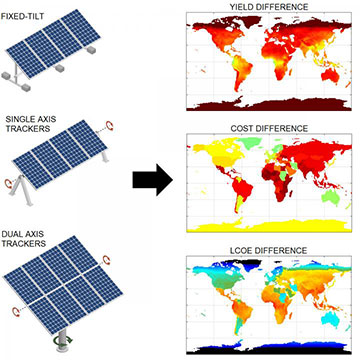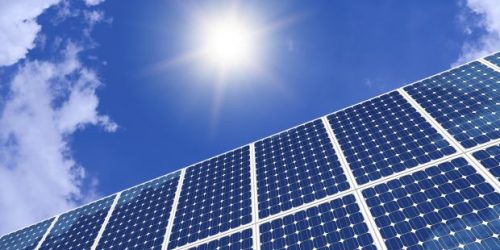Solar-power farms could increase average yield 35% to 40% simply by mounting double-sided photovoltaic (PV) panels on trackers to follow the sun, a multinational research team reports.
The team—led by Carlos D. Rodríguez-Gallegos, a research fellow at the Solar Energy Research Institute of Singapore, which is part of the National University of Singapore—analyzed, on a global basis, two types of conventional silicon solar photovoltaic panels (mono- and bifacial) and single- or double-axis tracking systems to move the panels as they follow the sun throughout the day. Team members included researchers at Sandia National Laboratories and MIT in the U.S.; China’s Harbin Institute of Technology, and Germany’s Helmholtz Institute Erlangen-Nürnberg for Renewable Energy.
Conventional tracking systems have been around for years, Rodríguez says. The study focused on combining trackers with one of the most promising new solar technologies: bifacial PV modules, which absorb sunlight also from their backside. The combination, he says, reduces the levelized cost of electricity (LCOE)—the cost of the system divided by lifetime energy output—which has become increasingly competitive for developers to win solar PV projects.
Squeezing out the kilowatt hours
The aim is to “squeeze out every possible kilowatt-hour” from a given PV installation, Rodríguez says. “Tracking systems are able to do so, although at slightly higher initial capital, and operations and maintenance cost,” he says. Mono-facial PV panels on fixed-tilt mounts are still the most common configuration, the study notes.
Rodríguez says stakeholders in every phase of the booming solar energy business are constantly looking at ways to improve system efficiencies. In many parts of the world, the researchers note, solar PV electricity generation has become cheaper than electricity from conventional sources like oil, gas, and in some countries even coal.
The quality of a solar installation is gauged by how much energy it produces over its lifetime, with solar cell efficiency as the figure of merit in the PV community, Rodríguez says. Improving efficiencies (through improved solar cell technology, for example) without adding much cost, is the most common research effort, he adds.
“Yet the amount of energy produced by a panel—its energy yield—can also be increased by other techniques,” Rodríguez says. For the study, the team focused on the advantages of bifacial solar cells and tracking technology, in which a solar panel is tilted over time on a single or dual axis to follow the sun.
Satellite data for sun-seekers

The researchers performed a worldwide techno-economic analysis for photovoltaic systems using a combination of bifacial modules and single- and dual-axis trackers. They found that single-axis trackers with bifacial modules achieve the lowest LCOE in most locations (16% reduction on average).
The researchers used data from NASA’s Clouds and the Earth’s Radiant Energy System satellite to measure total solar radiation bathing the Earth each day. They tailored those data to determine how the sun’s position will influence the amount of solar radiation a PV panel will receive based on its orientation. They then calculated the average net cost of generating electricity throughout the lifetime of such a PV system.
The researchers validated their model with experimental setups at their institutions in the U.S., Australia, China, Germany and Singapore.
“Ideally we wanted to have data under different climate conditions, which was achieved by the collaboration of the three institutions and their wealth of data provided,” Rodríguez says.
For the modeling work, Rodríguez used MATLAB software available to many researchers. “Readers can verify the results that we obtained,” he says.
“The open question we wanted to answer,” Rodríguez says, was “how well do these technologies, in which parts of the world, and in which combination, give the highest yield and lowest LCOE?”
Finding sunnier options
The most cost-effective option, for most locations, is to combine single-axis trackers with bifacial solar cells, Rodríguez says. On average, this combination reduces electricity costs by 16%, while improving yield by 35%.
According to Rodríguez, “The single-axis bifacial combination is favorable almost anywhere on the planet, given current system and panel costs.”
Close to the Earth’s poles, however, “we find that dual-axis trackers are preferable,” Rodríguez says. These trackers follow the sun’s path even more accurately, and generate on average 40% more energy, he says. Still, they are more expensive and so economically not as desirable.
The overall system cost is strongly influenced by system size, Rodríguez says. “As a general rule, the smaller the PV system, the higher the expected cost per installed module. In our work we considered the cost associated to large PV farms, which are installations composed of thousands of solar panels.”
“The results are stable even for changes in weather conditions and in the cost of the solar panels,” says Rodríguez, “as well as other system components.”
On to tandem solar cells
Moving forward, the team has begun work to analyze the yield of tandem solar cells. Tandem solar cells, optimized to each portion of the spectrum, are comprised of a top cell to collect high-energy photons and a bottom cell to collect lower-energy photons. They are most often used as solar concentrators or in space applications and are still prohibitively expensive for terrestrial PV installations.
Nonetheless, tandem solar cells “have the potential to reach efficiencies beyond the 30% mark,” Rodríguez says. “We aim to be a step ahead so that our research can be used as a guide for scientists, manufacturers, installers and investors by the time they are commercially available.”





